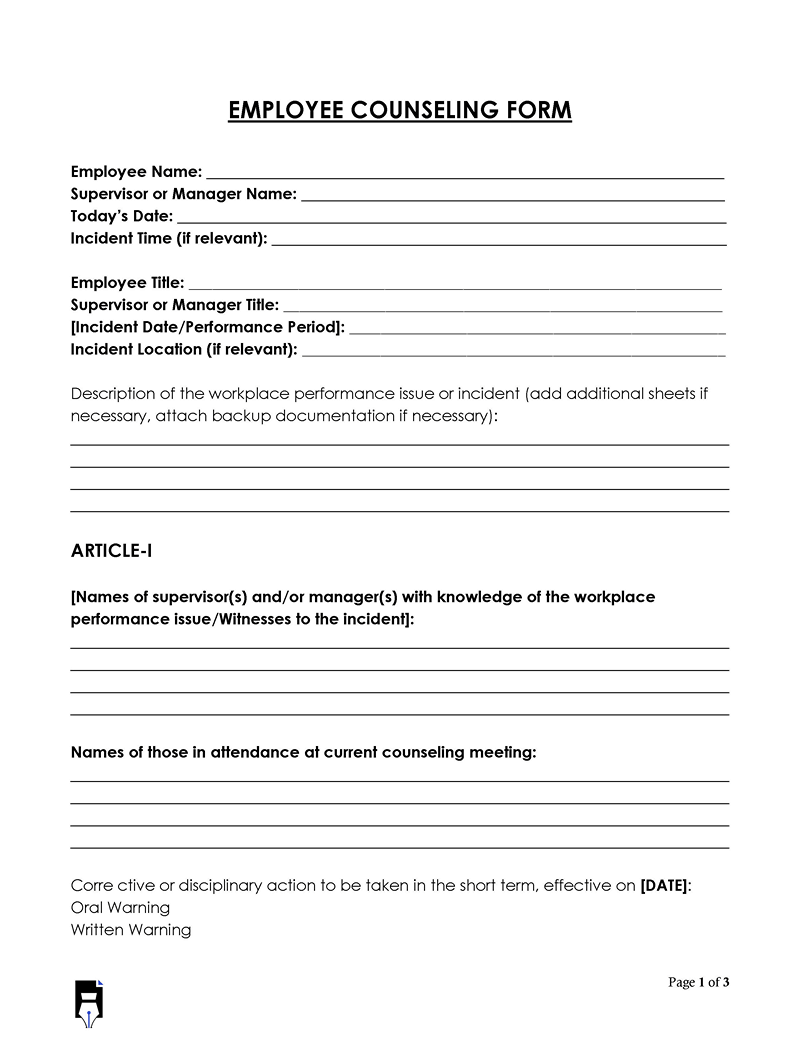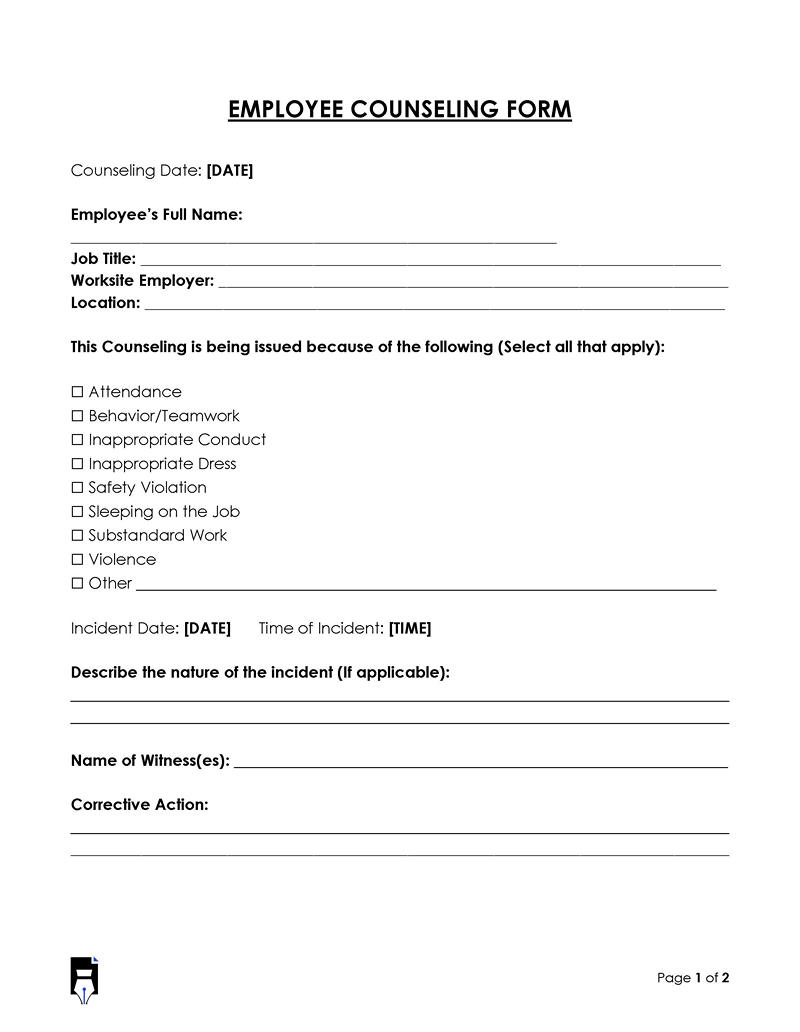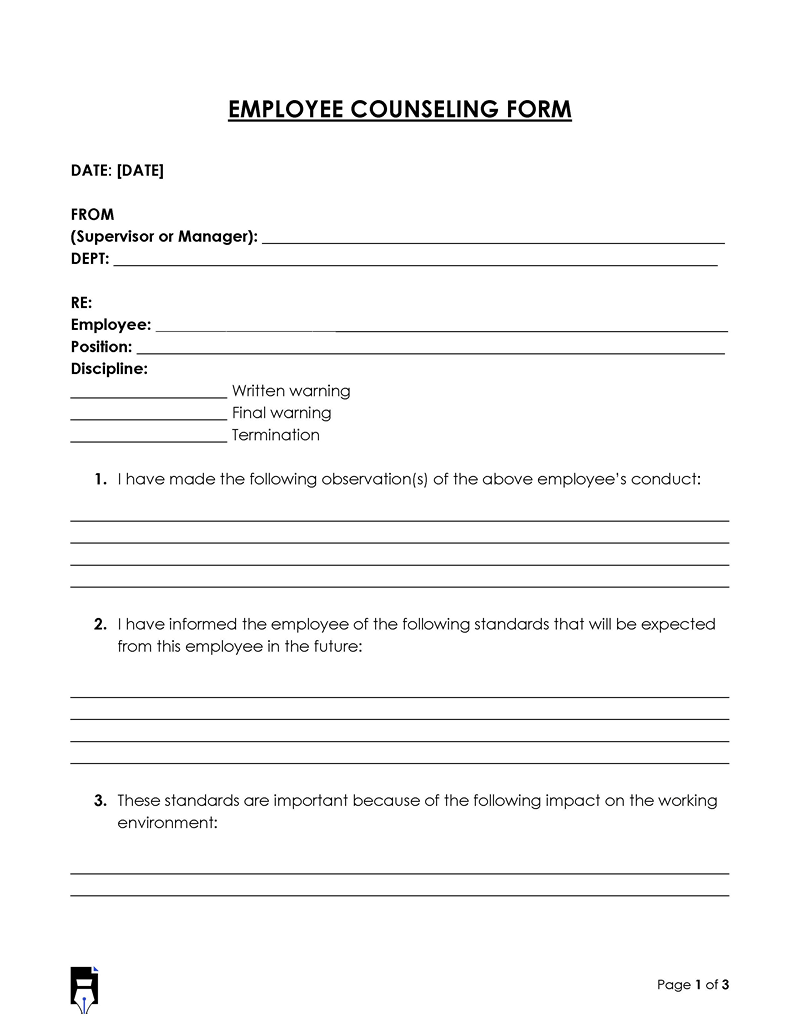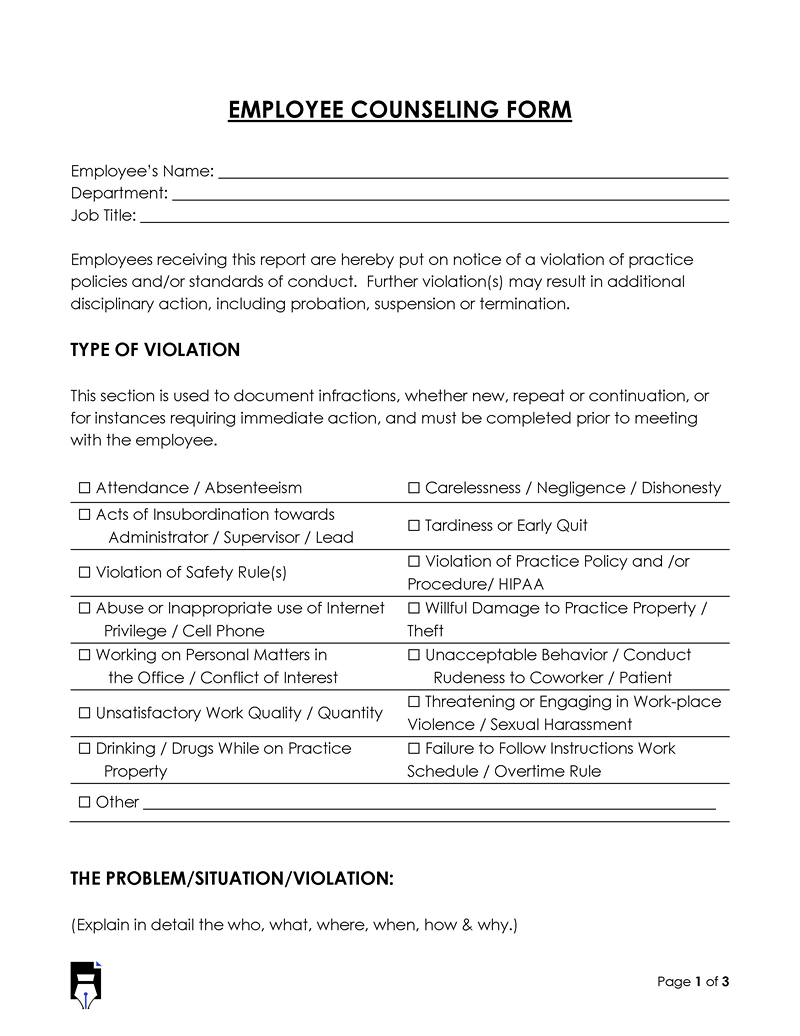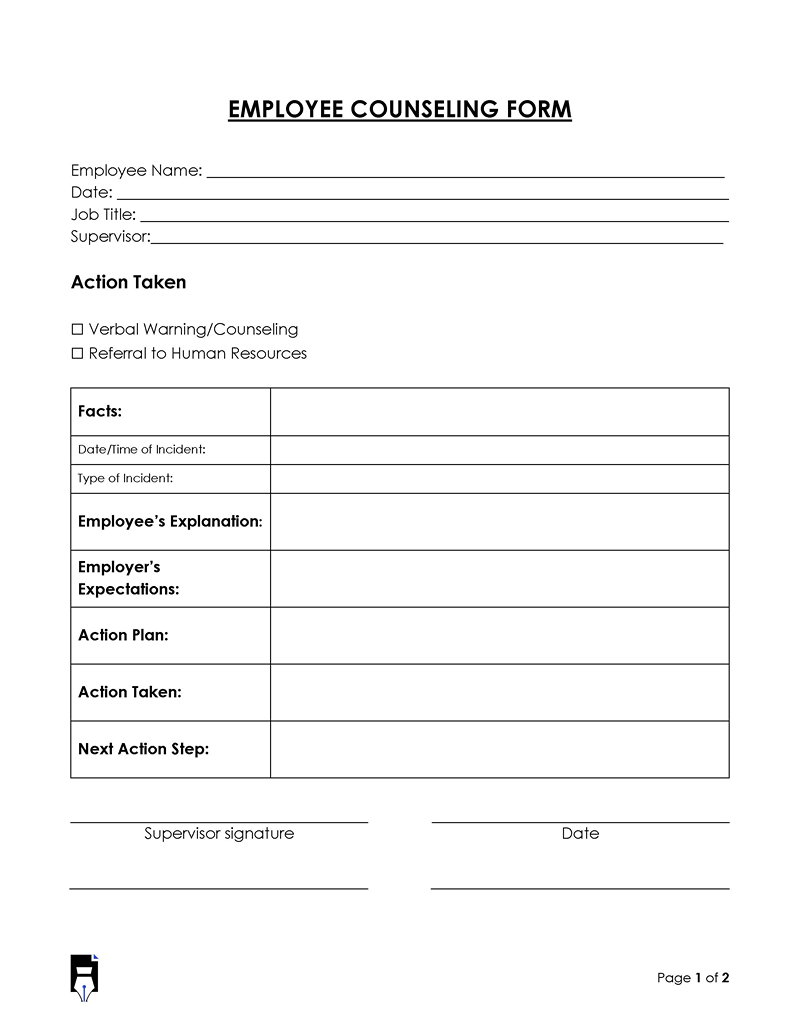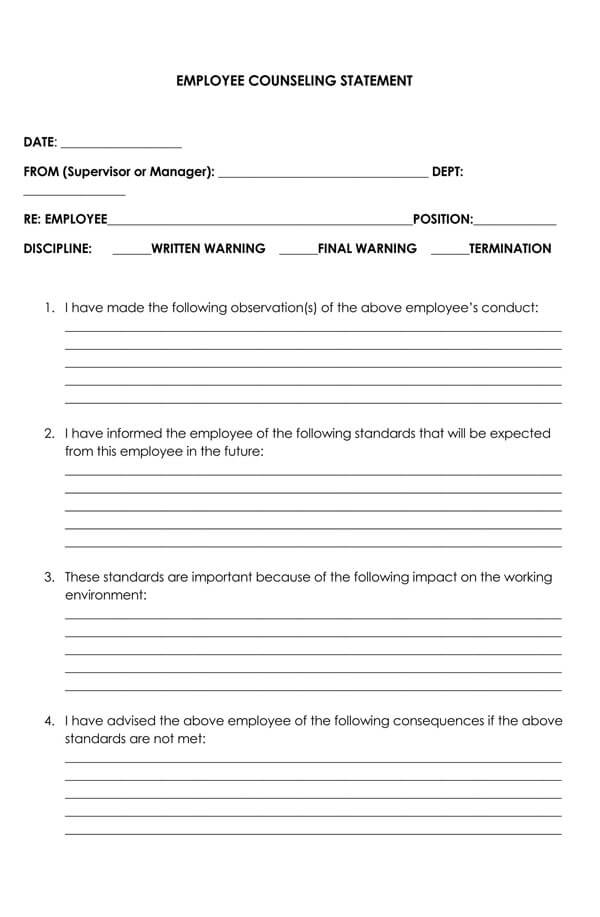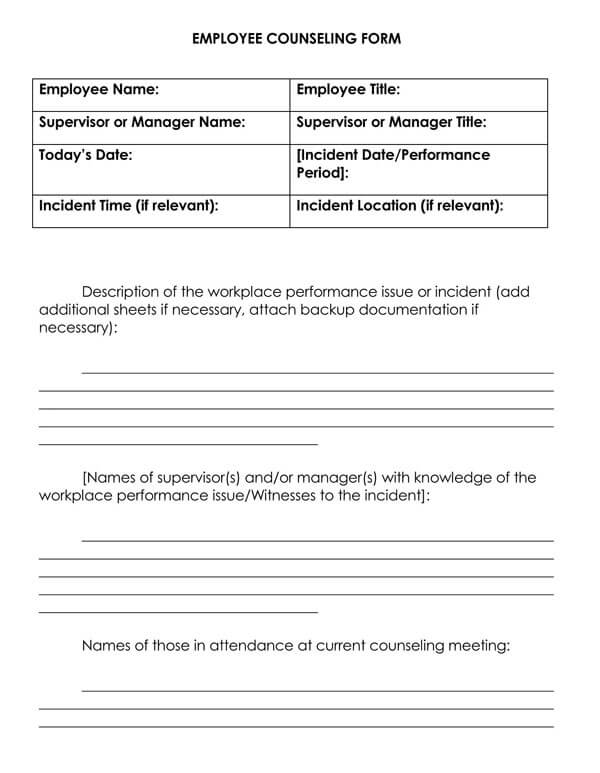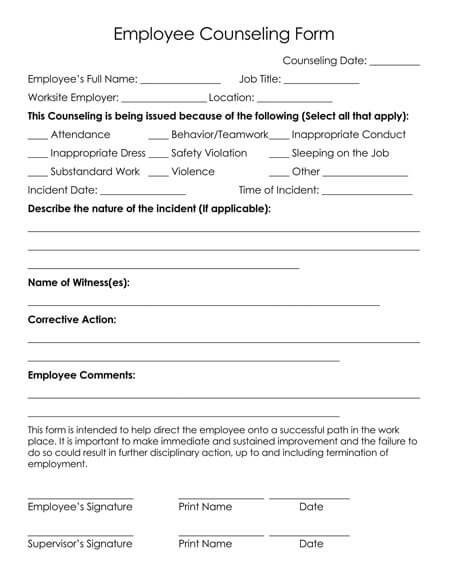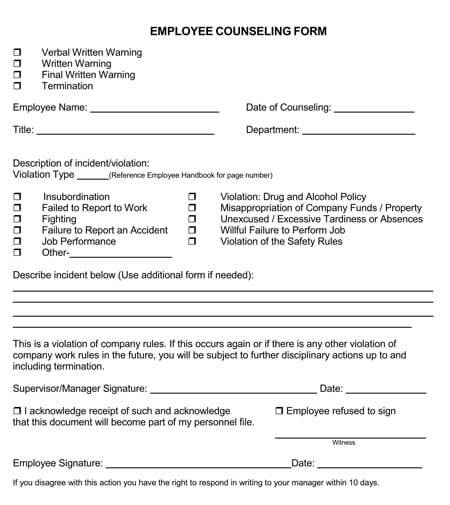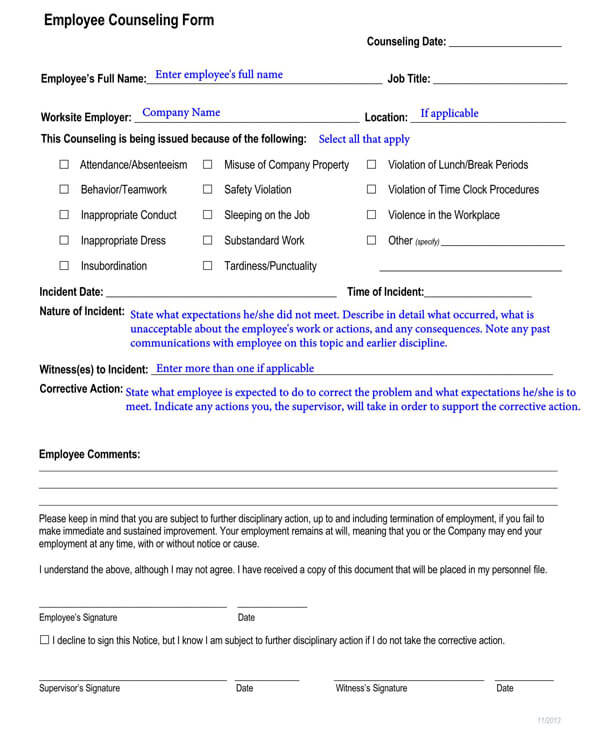An employee counselling form is a pre-prepared document that acts as a guide to a counsellor/supervisor on the information that should be discussed in an employee’s counselling meeting.
An employee counselling form is also used to document the findings of a counselling session and can be used for reference in the future should the need arise. In the employee counselling form, a counsellor fills in why or what led to the need for the counselling session, details about an incident that raised some concern from management, and the corrective action to be taken to this effect.
In any working environment, employees are prone to undergo some stressful moments from time to time. These moments can lead to psychological problems such as anxiety or depression. These problems arise from the different activities and interactions within the workplace. Outside their workplace, employees also go through trying times in their personal lives, financially and psychologically, for example, due to lack of personal time to attend to personal commitments or domestic problems.
Therefore, the different issues faced by employees can be categorized into; personal, job performance, societal, and family problems. An employee’s performance is expected by management to still be up to standard despite these challenges. The efforts required to meet these needs and expectations can be draining and maybe depressing to employees.
This, in turn, reduces their effectiveness at work and productivity at work, potentially making them a liability. Such impacts have necessitated the implementation of employee counselling within a company.
What is Employee Counselling?
Employee counselling is a human resource tool that is devoted to attracting, train, motivate and retaining highly skilled and committed employees in order to get a competitive advantage over rival companies. It is carried out to listen, understand an employee’s problems, and provide guidance and advice on different ways to solve them.
Counselling is done through sessions where a supervisor and an employee meet to discuss a particular incident or an employee’s decline in performance. Counselling is carried out privately and face-to-face, where a counsellor tries to understand the employee’s problems and advise them accordingly.
Counselling can be carried out by different people depending on the size and capability of a company; in small organizations, the manager can assume this role, whereas else in large organizations, usually a professional counsellor is hired. However, it is essential to note that counselling is not a form of punishment but rather a corrective measure.
Employee Counselling Forms
Advantages of Employee Counselling
Employee counselling provides employees with an opportunity to share and discuss day-to-day conflicts and problems they experience while working in a company.
Employee counselling has various advantages that cut across different aspects of a business. Primarily, employee counselling motivates and increases the quality of a company’s workforce and helps them actualize their full potential. The ripple effect is an increase in performance, improved quality of products and services, good interpersonal relationships between employees, a conducive working environment, and profits.
- Counselling helps an employer understand an employee’s perspective of various aspects of a company, such as policies and guidelines, and can therefore adjust them in a mutually agreeable context that reduces their shortcomings.
- Counselling helps retain employees for a significant duration which saves on operating costs and affordability as employees feel appreciated and valued.
- Absenteeism is reduced as the employee(s) feel motivated and confident to carry out their duties and hence report to work when they should.
- Counselling helps improve communication between management and employees as the staff has a platform they can speak up without the fear of being fired. This, in turn, informs management of potential problems they might not be aware of.
Pre-session Considerations
The employee should be notified ahead of time, and an agreeable time should be set to hold the session. Make sure to inform them of the reason(s) as to why the meeting is being called. Remind the employee that it is not a disciplinary action, although should the employee not rectify the identified shortcomings, further course of action would be taken. It is also important to make the employee aware that the session is being documented and what the counsellor intends to do with the form.
This creates an environment that invites honesty, and hence the employee would be compelled to share more. You should look for a space that is private and free from interruption to conduct the counselling session.
Employee counselling is devoted to equipping the employees with the right attitude and motivation to carry out their duties in their respective workplaces.
To ensure a counselling session achieves its intended purpose, you should consider factors;
Collect necessary documentation
Collecting the necessary information associated with the incident or problem helps you prepare an array of questions that you feel if answered, would help you understand the incident better. The type of information could be an employee’s record of attendance, receipts, performance evaluations from supervisors, customer feedback, or co-workers’ complaints. From that information, you can build an evidence-based case that shows when and what happened.
Among the information to be gathered is the determining the roles and responsibilities of the employee in question and company policies; this helps identify cases in which an employee is within their permissible limits either in attendance or other requirements. You should look for a space that is private and free from interruption to conduct the counselling session.
Understand how the employee’s conduct does not meet expectations
An employee cannot be at fault if, at all, they were not expected to meet some level of quality or quantity in terms of service or product. A counsellor should be able to draw a clear line between what was expected and what actually happened. The employee should be notified ahead of time, and an agreeable time is set to hold the session.
Highlight the consequences of the shortcoming
Since most companies rely on the efficiency of every department/employee to produce high-quality goods and services, poor performance by one department/employee can undo the effort put in by other employees and impact the whole workplace. Try and show the employee how this is so when explaining to them the importance of their contribution to the company. This makes an employee feel valued, which can go a long way to increase their confidence to overcome personal problems they might be going through. Remind the employee that it is not a disciplinary action, although should the employee not rectify the identified shortcomings, further course of action would be taken.
What to Include in an Employee Counselling Form
There are several things a good employee counselling form should contain.
They can be categorized into the following;
Employee information
The employee counselling form should include the employee’s information, such as their full name, job position, and employer. This information is provided at the very top of the form. The date when the counselling session is to take place should also be indicated.
The reason(s) for counselling
There are diverse reasons why an employee would require counselling, and they should be declared in the employee counselling form. The reason could range from unethical behaviour, reduced performance, harassment, poor attendance, or company safety policy violation. Any policies that the employee agreed to when joining the company can be quoted in this section.
Details and nature of the incident and names of witnesses
Highlight further information about the incident, like when and how it happened. This is important for documentation and future reference purposes. In cases where there were witnesses to these allegations, indicate their names.
If at all, there were prior counselling sessions concerning the incident, the date, and any agreements made should be pointed out in the employee counselling form.
Corrective action(s)
Since the objective of the counselling session is to arrive at an agreeable solution to the problem, the counsellor should suggest or pass on the employer’s suggestions to the employee on how best the incident should be corrected. This includes the effective date when the corrective actions are to be implemented and how follow-ups are to be made to verify if the employee is committed to change.
Employee comments
An employee counselling form should also include any comments or issues raised by the employee. This consists of any disagreements or objections to the allegations raised against them.
Future actions
As already established, continued poor performance can be detrimental to a business, and sometimes termination of employment could be the right course of action. Therefore, it is essential to state the eventual consequences of disregarding the corrective actions in the employee counselling form.
Signatures
There should be a provision for the employee and the counsellor/supervisor to sign at the bottom of the employee counselling form. A signature is a proof that the employee acknowledges the issue and the session and what was agreed in that meeting.
Development and Execution of a Follow-Up Plan
The employee and the counsellor should come up with an action plan that resolves the issues discussed in the session. A strategy of implementing these actions should be developed, including the effective day when this should start. A follow-up program that shows genuine concern for the employee’s well-being and progress at work should be crafted. A follow-up schedule should be based on a routine of frequent actions. The interval duration should also be agreed on.
A follow-up plan, in simple words, evaluates the success of the session. If the issues persist, an employer could choose to call for another session or take the necessary actions that were agreed on during the previous meeting. There are various ways an employee can be evaluated; for example, if the issue was attendance, you can ask the employee to always sign at the receptionist desk or avail themselves at the human resource office upon reporting to work.
The plan is often used by the human resources head to determine the effectiveness of the counselling sessions in a company. It can be used to identify the gaps in counselling and company policies and determine unprecedented causes of issues within the company.
Free Employee Counselling Form Templates
Coming up with an employee counselling form every time you require one can be a monotonous and overwhelming task; therefore, we have provided free downloadable employee counselling form templates for you to download. Once you download, you can customize the template to fit your requirements. This reduces your workload to a great extent. Why go through the hustle of writing an employee counselling form when you are just a few clicks away from access to one?
Tips on Conducting Employee Counseling
There are a few things you can incorporate in your counselling session to make it successful. For example;
Be a good listener
Always listen to the employee’s remarks even if you disagree with them. As a good listener, waiting for the employee to finish their sentences before you can interject motivates them to share more. An occasional nod when listening can reassure them that you are paying attention to what they are saying. It is also important to make the employee aware that the session is being documented and what the counsellor intends to do with the employee counselling form. This creates an environment that invites honesty, and hence the employee would be compelled to share more.
Focus on the issue and not the person
Regardless of how major or trivial the issue may seem, the fact that it affects their performance, you should always strive to find a solution for it. Therefore, this should be your main focus throughout the session.
Focus on the employee’s strengths
While providing solutions, try to base them on the employee’s strengths as this helps improve their confidence and acts as a reminder of their capabilities. Remind the employee of the employer’s trust bestowed on them by allocating different roles and responsibilities within the company; such trust is a morale booster.
Give your input
Do not hesitate to give your opinion, for as a counsellor, you provide a different set of eyes and perceptions to the issue at hand. This should come after understanding and analyzing the problem. Hasty advice should be avoided as it could be misleading. However, not all the solutions should come from you; the employee’s views should come into play, thus generating a sense of ownership in the final corrective action. This, in turn, raises their confidence in their capabilities.
Choosing the right counselor
Ideally, the department supervisor should be the one to conduct the counselling session as they are more familiar with the employee and in a better position to notice changes in behaviour and patterns in the working schedule. However, if the employee counselling form is to be handed to Human Resources, it is recommended that an HR member should be involved. This is often when the issues are paramount. A professional counsellor’s services are required when the issues are identified to be substantial or mentally health-related.
Conclusion
Counselling is slowly becoming a significant part of our current society, and this is being reflected in businesses too. Challenges will always be present in a person’s life, and despite what one might be going through, they are expected to carry out their responsibilities at work with the same quality and intensity the employer requires. A good counselling session should help the employee get back on track and encourage them to perform up to their full potential.
Developing a good employee counselling form helps the counsellor be objective when conducting a session. Listening is a vital aspect of counselling. Employers should use employees’ suggestions given during counselling to formulate company policies and guidelines to ease the process of implementation. A good follow plan plays a huge role in increasing the effectiveness of an employee’s counselling session. If well done, counselling can significantly improve employees’ productivity in a company, making it an essential part of today’s human resource management.
